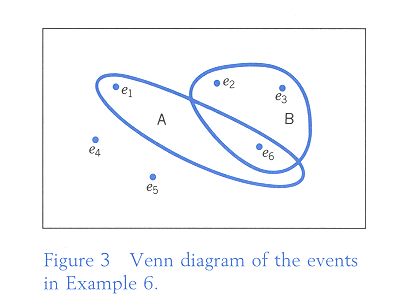
Suppose two monkeys will be selected by lottery and assigned to an experimental drug. Considering all possible choices of two monkeys, make a Venn digram and show the following events.

Here the elementary outcomes are the possible choices of a pair of numbers from
![]() .
These pairs are listed and labeled as
e1,e2,e3,e4,e5,e6for ease of reference.
.
These pairs are listed and labeled as
e1,e2,e3,e4,e5,e6for ease of reference.
The pair ![]() hasboth monkeys of the same type, and so does the pair
hasboth monkeys of the same type, and so does the pair
![]() .
Consequently,
.
Consequently,
![]() .
Those with the same ages are
.
Those with the same ages are
![]() ,
,
![]() ,
and
,
and ![]() ,
so
,
so
![]() .
And the diagram.
.
And the diagram.

The pairs consisting of different types are ![]() ,
,
![]() ,
,
![]() ,
and
,
and ![]() ,
so
,
so
![]() .
The event
.
The event
![]() is the same
as the event C. Employing the definitions of union and intersection, we obtain
is the same
as the event C. Employing the definitions of union and intersection, we obtain
